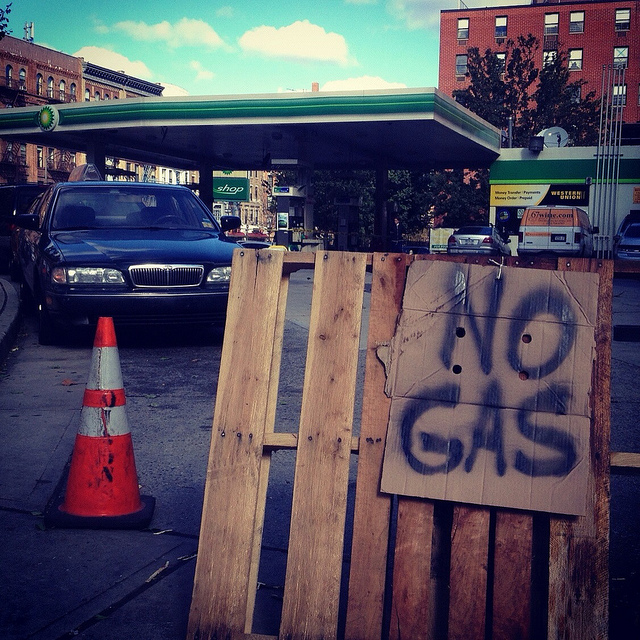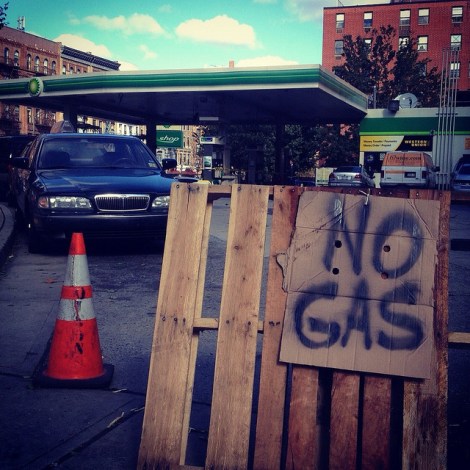When Sandy hit the New York metropolitan area, the first thing to go was the electricity. The second thing to go was the gasoline.
Reuters has a lengthy look at how one of the busiest regions of America suddenly found itself short on fuel, leading to shuttered gas stations, price spikes, and rationing that only ended in New York City last week.
The storm’s destructive powers were bad enough — knocking out equipment and power at oil terminals and other energy infrastructure, while disrupting shipping for days because of debris in the harbor. But a series of decisions over recent years had also made the region much more vulnerable. The shuttering of regional oil refineries, decisions by companies to keep low fuel stocks because holding extra supply has become expensive or unprofitable, a recent government downsizing of emergency reserves, and the heavy reliance of fuel terminals on a vulnerable electric grid all played into the supply squeeze.
New York Harbor plays a key role in the area’s fuel infrastructure. So for Commander Linda Sturgis, who leads emergency prevention at the Port of New York, the effects of the storm were immediately obvious.
Live feeds from military cameras in secret locations allowed Sturgis to watch Sandy raise sea levels by as much as 14 feet. That, she knew, would submerge low-lying zones, with frightening implications for residents. But Sturgis, who also holds a business degree in supply chain management, recognized another threat too.
“When I saw that surge, I knew it would impact oil supplies,” she says. “The public probably doesn’t realize how critical the harbor is. It’s the epicenter of fuel distribution for the whole Northeast.” …
Sturgis said Phillips 66, operator of the 238,000 barrel per day Bayway refinery in Linden, New Jersey, reported that a 13-foot surge of corrosive saltwater had inundated parts of the plant. Its power was out, and the plant — known among oil traders as “the gasoline machine” because it produces enough fuel to meet half of New Jersey’s demand — had no timeline for restarting.
Another low-lying Harbor refinery, Hess Corp’s 70,000 barrel-per-day plant in Port Reading, New Jersey, was also incapacitated by power outages. Along the coast, two dozen major fuel terminals were inoperable. Tanks at the terminals store and blend oil to ship around the region.
Supplies in the region were already depleted from people buying fuel in preparation for the storm. (Reuters notes that, according to MasterCard, fuel sales in the area were 65 percent above normal before Sandy hit.) But when the water receded, and barges with fuel would normally move in to resupply gas stations, they discovered that the harbor wasn’t operational. Power outages and lingering effects of flooding meant it couldn’t process the deliveries.
Thousands of fuel truckers were forced to improvise. One national shipper, Mansfield Logistics, diverted trucks for hundreds of miles in every direction, bringing fuel from as far as North Carolina to northeastern customers, some located just a few miles from the harbor’s tanks.
The crunch was worsened because many regional filling stations lacked generators and couldn’t dispense gasoline. …
Government officials tried several fixes. The Environmental Protection Agency eased clean fuel standards, allowing emergency vehicles and generators to run on dirtier fuel oil, and federal officials approved Jones Act waivers to lure fuel cargoes on foreign-flagged tankers usually barred from transiting between U.S. ports. BP Plc diverted a Liberian-flagged ship to the harbor, but only a few other cargoes arrived quickly.
The damage was so widespread that there was only one sure-fire solution to the problem: time. Gas stations and the port slowly powered back up; damaged refineries came back online, each on its own timeline.
The Reuters report suggests that there are places that can provide guidance in avoiding this problem in the future: namely, Texas and Holland. The latter says it is prepared “even for the storm that only happens once every 10,000 years.”
Confidence in preparation is one thing. What actually happens in the aftermath of an unprecedented event is something else entirely.




